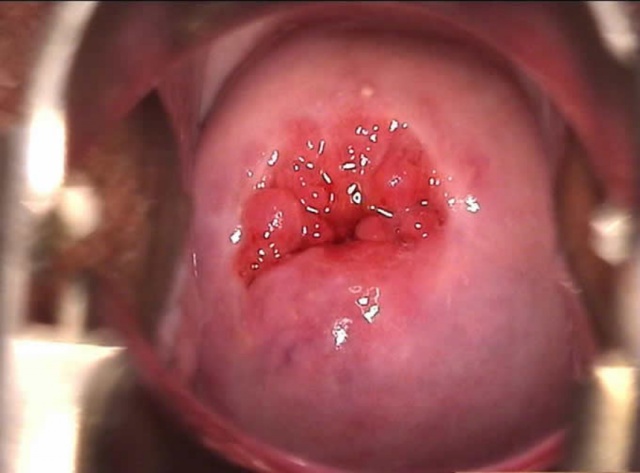Cervical erythroplakia is a violation of the natural structure of the epithelium covering the cervix, characterized by tissue atrophy. Pathology is rarely diagnosed, which makes it impossible to study the disease in detail. That is why it is still considered little studied. Erythroplakia is a precancerous condition and occurs in women of different ages. Below we will talk more about this disease and its treatment methods.
Cervical erythroplakia - what is it?
This term refers to the pathology of mucous tissues located closer to the entrance to the vagina. The disease is characterized by atrophy of the superficial epithelial layer of the cervix. The disease is considered poorly understood, so the information about it is incomplete and leaves many puzzles for professionals. Nevertheless, the disease is successfully treated and has a positive prognosis.
Erythroplakia of the cervix (code according to ICD-10 87) got its name because of the peculiarities of external manifestation. Translated from Greek, the name translates as "red spot". Pathology can develop both in women of childbearing age, and in patients during menopause or postmenopause. The disease is easily diagnosed and is often accompanied by inflammatory processes (colpitis or cervicitis).
Erythroplakia (see photo below) is a serious disease.

Since this condition is precancerous, it is timely diagnosis that is important. Proper treatment allows the patient to recover completely and reduce the likelihood of malignant neoplasms.
Most often, cervical erythroplakia (ICD-10 87) is asymptomatic, but in some cases it may be accompanied by mucous secretions and contact bleeding. When making a diagnosis, the doctor takes into account the data of extended colposcopy, vaginal examination in the mirrors, histological examination of the biopsy, as well as cytological analysis. Most often, the treatment of the disease is carried out surgically using minimally invasive techniques, and damage to the cirvial canal may be an indication for conization of the cervix.
Causes

Erythroplakia of the cervix is an insufficiently studied and extremely rare disease, the causes of which are not completely clear. Specialists distinguish several groups of women who are most susceptible to this pathology. Most often, the disease develops against the background of:
- Cervicitis (inflammation of the cervix).
- Infectious and inflammatory processes of a different nature.
- Dysplasia
- Various forms of colpitis.
In addition, abnormalities in the structure of the epithelium can be triggered by injuries received during:
- damage to the cervix during childbirth;
- abortion;
- the use of chemically aggressive methods of contraception;
- performing therapeutic or diagnostic curettage.
Experts also believe that the development of erythroplakia of the cervix is facilitated by impaired regenerative processes of damaged tissues, hormonal imbalance, endocrine disorders and malfunctions of the immune system.
Of particular danger is the lack of estrogen. This is the reason for the violation of the correct formation of epithelial cells. Many doctors believe that erythroplakia can be transmitted genetically. In patients in whose genus a similar disease appeared on the female line, the risk of pathology increases significantly.
Symptoms of cervical erythroplakia

Most often, the disease is asymptomatic. Sometimes women notice minor bleeding that is not related to menstruation. This is due to trauma to the distal layer of epithelial tissue. If the disease develops against the background of a local infection, then it will occur with symptoms typical of inflammation. These include:
- The discomfort.
- Pain in the vagina.
- Abundant serous-purulent discharge.
During a gynecological examination, bright red areas are clearly visible on the surface of the cervix. Spots stand out against the background of healthy integuments, and has an uneven outline. Redness of the mucous tissue during erythroplakia occurs due to thinning of the epithelium, due to which the blood vessels are visible. Visually, the area of inflammation looks like a shiny spot that begins to bleed from any slightest damage (with tools or fingers).
Diagnostics

The cervical erythroplaky protocol does not present any special difficulties in diagnosing. Confirm the disease and exclude oncology allow:
- Examination on a gynecological chair. On the surface of epithelial tissues, bright red or burgundy areas are visible, with clear boundaries and irregular shape. If you touch the affected area, it may begin to bleed.
- Advanced colposcopy. Through the thinned tissue, the stroma of the cervix is visible. When conducting the Schiller test (treatment of the epithelium with Lugol), the affected areas are not stained, and when 3% acetic acid is applied, they turn pale.
- Scraping cytology. This analysis reveals an increase in the number of basal cells with signs of atypia. If there are a lot of atypical cells, the attending physician prescribes an aimed or conchotomic biopsy, as well as a study of the histology of erythroplakia of the cervix.
If the disease is combined with infectious pathologies, a smear culture test, serological methods and PCR diagnostics are additionally used. An ultrasound can be prescribed to assess the general condition of the pelvic organs. Erythroplakia can provoke cervical cancer, precancerous background conditions, endometriosis, leukoplakia, true erosion, cervicitis, adenomatosis, dysplasia. In difficult situations, an oncologist is involved in the diagnosis.
It is worth noting that most often the disease is detected after a standard examination on a chair. Additional tests are needed to rule out concomitant pathologies, including cancer.
Treatment

Specialists are considering two types of treatment for cervical erythroplakia: conservative and surgical, destroying pathological areas. Before choosing the appropriate therapy, the doctor considers the causes of the disease and the current symptoms.
Treatment is possible using the following methods:
- By cauterizing the affected area with electric shock.
- Liquid nitrogen treatment.
- Treatment of erythroplakia of the cervix with hormones.
- Exposure to affected areas with radio waves or a laser.
If necessary, conization of the cervix is performed. This type of therapy can be performed using a knife, laser or loop. The attending gynecologist selects the necessary therapy, based on the results obtained during the diagnostic study.
Medicines

In most cases, gynecologists prescribe medication to patients by taking immunostimulating and antiviral drugs, such as Panavir, Acyclovir, Immunal, Famvir, Polyoxidonium, interferons and other drugs. The duration of the course is determined by the doctor. If necessary, apply vaginal suppositories and creams.
The main task during the treatment of erythroplakia is the removal of existing inflammation. It is possible to start therapy aimed at treating the pathology itself only after eliminating the inflammatory processes. Cauterization by any methods is carried out only on conditionally healthy tissues, after which the patient is prescribed drugs that have wound healing and antiseptic properties: Galavit, D-panthenol, Suporon suppositories and similar drugs.
Hormones
In the event that the cause of erythroplakia is hormonal failure, treatment is carried out by adjusting the background. Removal of the abnormal area is possible only after the normalization of the menstrual cycle. Most often, the following tools are used for this:
- Triziston.
- "Utrozhestan".
- "Anteovin."
- Lindinet and others.
The appointment of hormonal drugs is made only after tests to determine the level of hormones in the blood.
Electric shock
This method is called diathermocoagulation. It is one of the oldest treatments. During the procedure, the affected area is exposed to high-frequency electric current. The duration of such treatment is about half an hour, the effectiveness is more than 70%, it may take from 2 to 4 months to fully recover from the procedure.
This type of treatment is accompanied by complications, including scars on the cervix, which cause narrowing of the cervical canal. Electric current moxibustion is prescribed only for women who give birth, who no longer plan to become pregnant.
Cryodestruction
This procedure involves exposure to atrophied areas with liquid nitrogen. In this case, the damaged areas are destroyed, and healthy tissues are simply frozen. The recovery period after cryodestruction takes from 8 to 12 weeks. This method is not applicable if the size of erythroplakia exceeds five millimeters. The advantage of liquid nitrogen therapy is the absence of scars and soreness. After completing the procedure, the patient can immediately go home and does not need hospitalization.
It is worth noting that if the doctor does not have sufficient practice, trauma to the walls of the vagina and the re-occurrence of erythroplakia cannot be ruled out. The cause of relapse may be incomplete removal of atrophied sites.
Radio waves and laser

These procedures are painful, so pain relief is necessary before starting the session. Laser treatment is carried out between the fifth and seventh days from the beginning of the last menstruation.
It will take a month and a half to repair damaged tissue. During this period, a woman may experience soreness in the lower abdomen and light bleeding. All this is considered an acceptable norm. A complication may be the development of inflammation or infection of the treated area, but this can only be provoked by non-compliance with the recommendations of the gynecologist.
The radio wave method is used from the fourth to the ninth day from the beginning of the last menstruation, since it is at this time that bleeding is unlikely, and the tissues recover much faster. The procedure takes no more than 15 minutes, and a full recovery occurs in a month.
Effects
The lack of timely treatment for erythroplasty of the cervix can lead to the transformation of the affected areas into malignant tumors. In this case, therapy can take much longer and will not always be successful.
It is worth knowing that erythroplakia refers to precancerous conditions and requires mandatory treatment. Since the disease proceeds almost always without symptoms, it is recommended that every woman undergo regular gynecological examinations.
Forecast and Prevention
With the timely detection and treatment of erythroplakia, the prognosis for recovery is favorable. Pathology malignant very rarely, relapse after surgery is practically not observed. Patients are recommended cytological, colposcopic and bacteriological control 1 month after the therapeutic event, and then once every 3 months for 1 year. Also, for prevention, it is necessary to regularly be examined by a gynecologist, treat inflammation of the reproductive system in a timely manner, refrain from unprotected sex and plan pregnancy.
Reviews
Reviews of patients suffering from this disease most often speak of a successful cure. Since in each case the disease proceeds differently, due to the individual characteristics of any organism, the method of treatment and its duration can only be determined by a doctor.